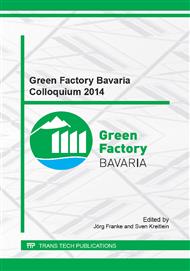[1]
Deutsches Institut für Normung, ISO/TR 14062: 2002: Environmental management - Integrating environmental aspects into product design and development.
Google Scholar
[2]
G. Reinhart.; S. Schindler, Strategic Evaluation of Technology Chains for Producing Companies, in: Enabling manufacturing competitiveness and economic sustainability, Springer, Berlin (2012).
DOI: 10.1007/978-3-642-23860-4_64
Google Scholar
[3]
Deutsches Institut für Normung, DIN EN ISO 14040: 2009-11: Environmental management - Life cycle assessment - Principles and framework.
Google Scholar
[4]
N. Bey, M.Z. Hausschild, T.C. McAloone, Drivers and barriers for implementation of environmental strategies in manufacturing companies, CIRP Annals 62 (2013) 43-36.
DOI: 10.1016/j.cirp.2013.03.001
Google Scholar
[5]
Deutsches Institut für Normung, DIN ISO 6789: 2013-10: Systematic arrangement of documents - Protection against falsification and quality criteria for the release of digital product data.
Google Scholar
[6]
M.J. Goedkoop, R Heijungs, M. Huijbregts, A. De Schryver, J. Struijs, R. Van Zelm, ReCiPe 2008, First edition Report I: Characterisation (2009) http: /www. lcia-recipe. net.
Google Scholar
[7]
EU JRC IES, Analysis of existing Environmental Impact Assessment methodologies for use in Life Cycle Assessment, ILCD handbook (2010).
Google Scholar
[8]
Deutsches Institut für Normung, DIN EN ISO 14001: 2009-11: Environmental management systems - Requirements with guidance for use.
Google Scholar
[9]
T. Ekvall, A. M. Tillman, Open-Loop Recycling: Criteria for Allocation Procedures, Int. J. LCA 2 (1997) 155- 162.
DOI: 10.1007/bf02978810
Google Scholar
[10]
A. L. Nicholson, A. Olivetti, J. R. Gregory, F. R. Field, R. E. Kirchain, End-of-life LCA allocation methods: open loop recycling impacts on robustness of material selection decisions, IEEE ISSST Symposium (2009).
DOI: 10.1109/issst.2009.5156769
Google Scholar
[11]
R. Frischknecht, Cut-off vs. avoided burden in metals'recycling: in view of environmental sustainability, risk perception and eco-efficiency, 33rd LCA forum November 22, 2007, Lausanne, Switzerland.
Google Scholar
[12]
P. Hofstetter, A structured approach to combine models of the technosphere, ecosphere and valuesphere in: Perspectives in Life Cycle Impact Assessment, Kluwer Academic Publishers, Boston/ Dordrecht/ London (1998).
DOI: 10.1007/bf02978561
Google Scholar


